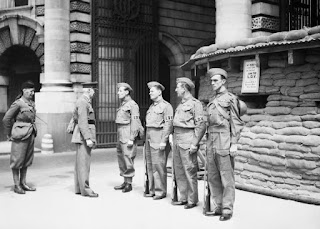Now we’ve all heard of the great fire of London which
happened in 1666, but have you ever considered how it would affect your family
history research?
I’ll start with some background. The fire started on the 2nd
September 1666 in Pudding Lane, London which was only a few streets north of
the river Thames. The fire started in a bakery and raged within the old city
walls of the city from the Strand to the Tower of London and as far north as
the Guildhall until the 6th September. During this time hundreds of
people were made homeless and had to flee the city. Surprisingly only 6 people
are reported to have died in the fire. Also in the fire the plague rats died!
 |
| Image courtesy of ancestryimages.com |
Now here is where the fire impacts of family history
research. 89 parish churches were lost in the fire including St Pauls. 35 of
these churches were never rebuilt.
So what does this mean to family historians? Well it means
you have to readjust what you know. The fire resulted in people having to move
from the area they lived in. So if you have been happily tracing your family
back through one church in London and then you can’t find anymore ancestors it
may be because they were new to the church just after 1666.
So what do you do? Well the best place to start is probably
to find out which parish churches were lost in the fire and find out which ones
were closest to where your ancestors lived after 1666. Although this will not
give you an accurate indication of where they moved from, it may help. Families
may have wanted to stay as close as possible to where they lived and worshiped
before as they worked in the area. On the other hand they may have move away as
they needed housing and where they worked may have been destroyed in the fire.
So how do you overcome this? Well don’t just focus on the
immediate area. If you can’t find what you’re looking for expand your search.
Also focus on what you know. If you ancestors were having children baptised at
a church from a certain date but you haven’t found the couple’s marriage there
then maybe they had to move church because it was lost in the fire. So from
here you need to look around the other churches. Also make a note of any
occupations listed on the children’s baptisms. This can help you if you find a
couple with the same names in another church. If the man has the same
occupation then there is a chance it is your ancestors. This may not always
follow though as they may have had to change job after the fire. If your
ancestors have an unusual surname then it is relatively easy to find where they
came from. Sorry to anyone with the name Smith as this will be difficult, but
congratulation if you have got back this far, you are a genealogy hero.
It has not been only the great fire of London that has
caused problems like this. There have been many disasters over the years that
may have resulted in your family having to move. If you have ancestors from
Sheffield you may suddenly find them disappearing as you go back. What may
people don’t know is that in 1864 Sheffield had a “great flood” when a newly
built dam wall cracked and the town was flooded. 240 people died and over 600
homes were lost. If your ancestors seem to suddenly appear in say north
Sheffield it could be they came from west Sheffield where the destruction
occurred.
 |
| A collapsing dam can relocate your ancestors |
The same moving of your ancestors could also have happened
if they were miners. Over the years they have been many mining disasters which
may have led to the closures of the pit. Your ancestors may have had to move to
new coal filed to get new jobs and so all of a sudden the Northumberland family
you thought you had is now in Yorkshire.
So although we don’t like to think about disasters such as
the great fire they do have an influence on our research as they change the
lives of our ancestors. So remember it may not be a brick wall you’ve hit, it
may be relocation.










